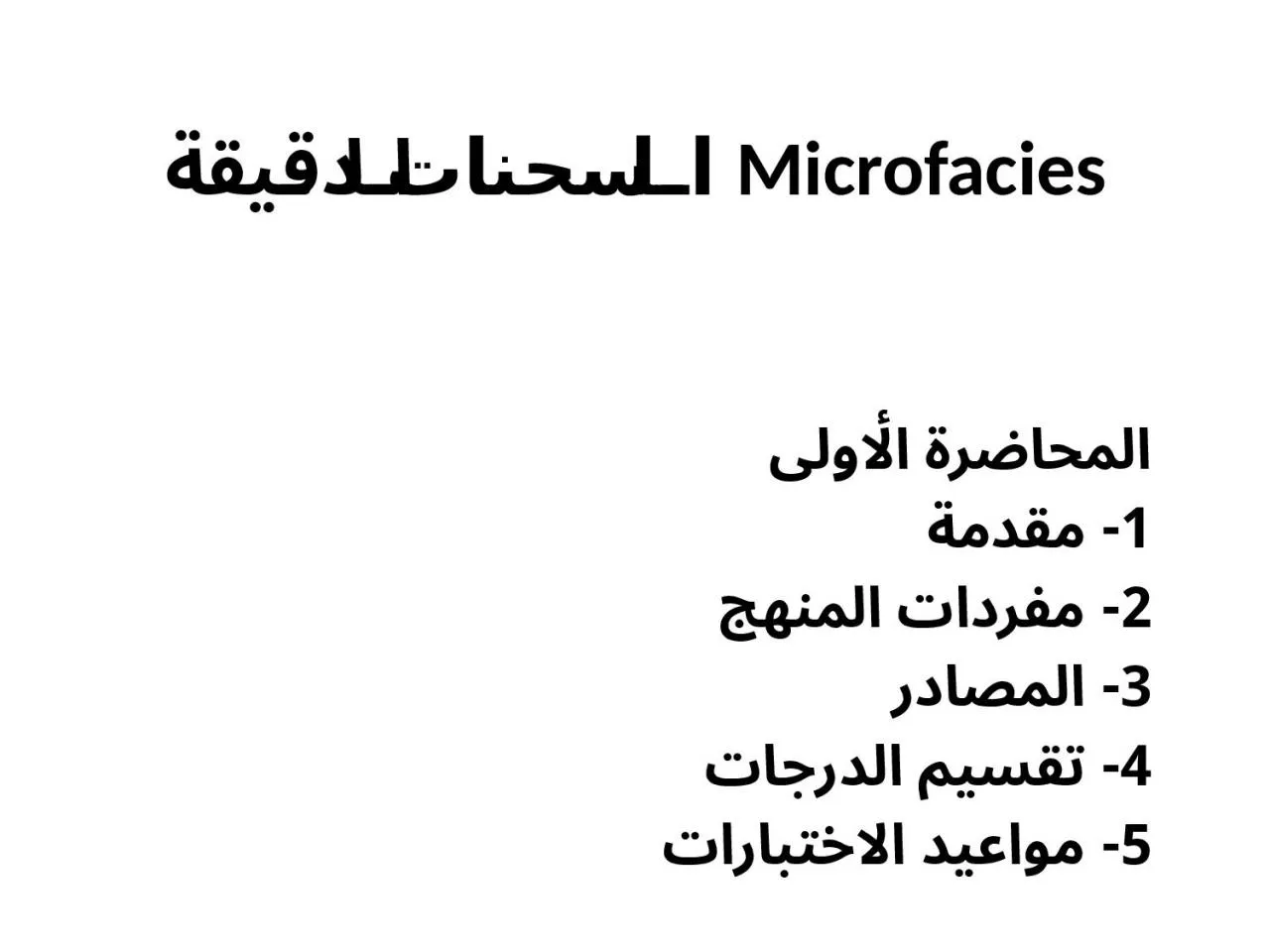

الدقيقة المحاضرة الأولى 1 مقدمة 2 مفردات المنهج 3 المصادر 4 تقسيم الدرجات 5 مواعيد الاختبارات Manual of carbonate ID: 1047481
Download Presentation The PPT/PDF document "Microfacies السحنات" is the property of its rightful owner. Permission is granted to download and print the materials on this web site for personal, non-commercial use only, and to display it on your personal computer provided you do not modify the materials and that you retain all copyright notices contained in the materials. By downloading content from our website, you accept the terms of this agreement.
1. Microfacies السحنات الدقيقة المحاضرة الأولى 1- مقدمة2- مفردات المنهج3- المصادر4- تقسيم الدرجات5- مواعيد الاختبارات
2. *Manual of carbonate sedimentology a lexicographical approach (Reijers & Hsu)Microfacies analysis of limestone (Erik flugel)*****Acolor illustrated guide to carbonate rocks constituents texture ,cements ,and porosities (AAPG)****Carbonate facies in geologic history (Wilson) *****A Color Guide to the Petrography of Carbonate Rocks: Grains, textures, porosity, diagenesis References
3. Key wordsMicrofacies , Carbonate rocks , Sedimentary Basin, Digenesis Process , porosity in thin section Classification of carbonate rocks , Standard Microfacies , Platform, Shelf , Epiric shelf ,Thin section
4.
5.
6.
7. Preface المقدمة Rock Typesأنواع الصخور
8.
9.
10.
11.
12. Microfacies SedimentologyPetroleum geologyHistorical geologySedimentary rocksStratigraphy Sequence stratigraphy Petrology Reservoir geology Paleontology paleoenvironment
13. Microfacies ProjectMicrofacies ProjectDescriptionAnalysisInterpretation
14. Carbonate MineralsCa co3
15. There are three type of carbonate mineralsCalcite caco3Aragonite caco3Dolomite CaMg (co3)2
16. Carbonate MineralsDolomiteCalciteAragonite
17.
18. How can carbonate rocks precipitationBiological Chemical Biochemical
19. نهاية المحاضرة الأولى
20. Carbonate Sedimentation In Marine Environments
21. -:Carbonate occur in 1- Eulittoral and supralittoral env. ( principally in tropical and subtropical env.) 2- Sublittoral env. (in water depth approximately between (20-200 m) (shelf and shelf margin) 3- deep sea (down to the calcite compensation depth between 4000- 5000 m (primarily planktonic sedimentation )
22. Basic Oceanographicall Classificationchart
23.
24. Setting of carbonate depositional environments
25.
26. Carboate Sedimentation Env.EulittoralSublittoralLake & terrestrialDeep Sea
27.
28.
29.
30. نهاية المحاضرة الثانية
31. Digenesis Process
32.
33.
34.
35.
36. نهاية المحاضرة الثالثة
37. Microfacies Characterization
38. Microfacies characteristics as seen in Thin section include of four criteriaThe type of groundmaasThe different kind of particalDepositional textureSolution texture
39. There are three elements of microfacies character :-2- Particles1- Groundmass3- Pores
40. Petro graphical components of MicrofaciesParticalGroundmassPoreSkeletalNon skeletalSpariteMicriteMICROFOSSILS1- OOLITE 2- PELLETS3-PELOIDS4- ONKOID5- AGREGATED GRAINSFABRIC SELECTIVENOT FABRIC SELECTIVE
41. Microfossils Shape In MicrofaciesNeedle SegmoidalPranchChamberMassiveIncarsted
42. Pore types in microfacies
43.
44. نهاية المحاضرة الرابعة
45. Classification Of Microfacies
46. Folk Classification
47.
48.
49.
50.
51. Dunham Classification
52.
53.
54.
55.
56.
57.
58. نهاية المحاضرة الخامسة
59. Standard Microfacies
60. Varied settings of carbonate deposits
61. Wilson’s Chart
62.
63. Facies Model
64. Evolution of Carbonate Sequences
65. SummaryVariations in carbonate depositional settings through time produce corresponding changes in their lateral and vertical facies geometry. High frequency changes in facies are induced by sea level, and climate, whereas long-term low frequency changes are commonly related to paleo-geography and plate configurations or the evolutionary changes in the carbonate producing organisms. The sections below provide a general and classical introduction to the eclectic responses of carbonates to changes in their setting. Click here to link to a more detailed examination of the details of the sequence stratigraphy of carbonates.
66. Controls On Carbonate Deposition
67. The geometry and facies relationships of carbonate accumulations are closely tied to the paleogeographic setting and changes in that setting through time, particularly water depth variation. Paleolatitude and clastic influx are major influences on the distribution of the carbonates, with facies largely controlled by the proximity of the depositional basin to open marine circulation and the position of the depositional setting within the basin. carbonate sediments and their associated buildups are largely the by products of organisms whose evolution has a significant influence on carbonate deposition. Wilson (1975) reviews in detail some of the similarities and differences that occur in carbonates of different ages.
68.
69. Platform Types1- Ramp2- Epiric Shelf3- Shelf
70.
71.
72.
73.
74.
75.
76. Location of carbonate basins on plate margins
77.
78.
79.
80.